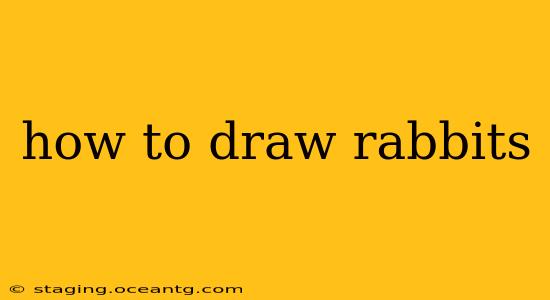Drawing rabbits can be a fun and rewarding experience, whether you're a seasoned artist or just starting out. This comprehensive guide will take you through the process step-by-step, from basic shapes to adding intricate details. We'll cover various styles and techniques to help you find your own unique approach to rabbit artistry.
Basic Shapes and Proportions: The Foundation of Your Rabbit Drawing
Before diving into the details, let's establish the fundamental shapes that form the rabbit's body. Think of a rabbit's body as a combination of simple shapes: a circle for the head, an oval for the body, and elongated ovals for the ears. Understanding these proportions is key to creating a realistic and well-proportioned rabbit.
Start by lightly sketching these basic shapes, paying attention to their relative sizes and positions. The head should be slightly smaller than the body, and the ears should be roughly the same height as the head or even taller. Experiment with different positions – a sitting rabbit will have different proportions than a hopping one.
Defining Features: Eyes, Nose, and Mouth
Once you have the basic shapes in place, it's time to add the defining features of your rabbit. The eyes are typically large and expressive, often dark and almond-shaped. The nose is small and rounded, often with a tiny triangle or a small circle to indicate the nostrils. The mouth is usually a simple, curved line.
Remember to consider the perspective. If your rabbit is facing you directly, the features will be centrally located. If it's turned slightly, you'll need to adjust their placement accordingly.
How do I draw realistic rabbit fur?
Achieving realistic fur requires understanding the direction and flow of the rabbit's fur. Instead of drawing individual hairs, focus on creating short, light strokes that follow the contours of the body. Vary the pressure of your pencil to create highlights and shadows, giving the fur depth and texture. Use lighter strokes for areas where the light hits, and darker strokes for shadowed areas. This layering technique adds significant realism to your drawing.
What are some easy ways to draw a bunny?
For a simplified approach, start with even simpler shapes: two overlapping circles for the head and body, and two long triangles for the ears. Add details like the eyes, nose, and mouth as described above. This method is perfect for beginners and quick sketches. You can later refine the shapes to make it more realistic or stylistic.
How to draw a cartoon rabbit?
Cartoon rabbits offer a lot of creative freedom. You can exaggerate their features, simplify their shapes, and use bolder lines. Think of characters like Bugs Bunny or Peter Rabbit – their exaggerated features are what make them instantly recognizable. Experiment with different expressions and poses to create unique and expressive characters.
What materials do I need to draw a rabbit?
The materials you need are relatively simple. A good quality pencil (HB or 2B), an eraser, and some drawing paper are all you'll need to get started. However, you can experiment with different mediums such as charcoal, colored pencils, or even digital art tools to achieve different effects and styles.
Adding Details and Refining Your Drawing
Once you're happy with the basic shapes and features, it's time to add details. This could include whiskers (long and delicate), paws (small and rounded), and a fluffy tail (small and round or long and bushy depending on the rabbit breed). Pay attention to the details in your reference photo (if you are using one). Consider adding shadows and highlights to create a sense of depth and realism. Gently erase any unnecessary guidelines, refine the lines, and add your finishing touches.
Different Rabbit Breeds and Poses
Rabbits come in various breeds, each with its unique characteristics. Research different breeds to understand their distinct features, like ear length and body shape. You can use this knowledge to create more accurate and diverse rabbit drawings. Explore different poses, too! A rabbit lounging, hopping, or nibbling on a carrot will all present unique artistic challenges and opportunities.
Remember, practice is key. The more you draw, the better you'll become at capturing the essence of a rabbit. Don't be afraid to experiment with different styles and techniques until you find the one that best suits your artistic vision. Happy drawing!
